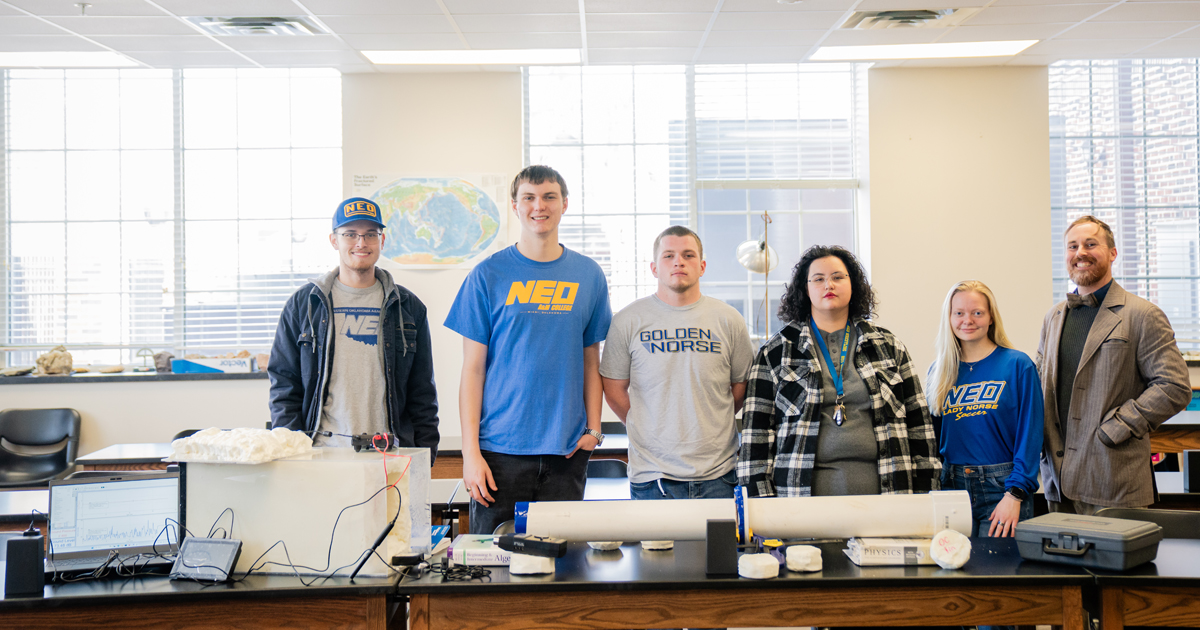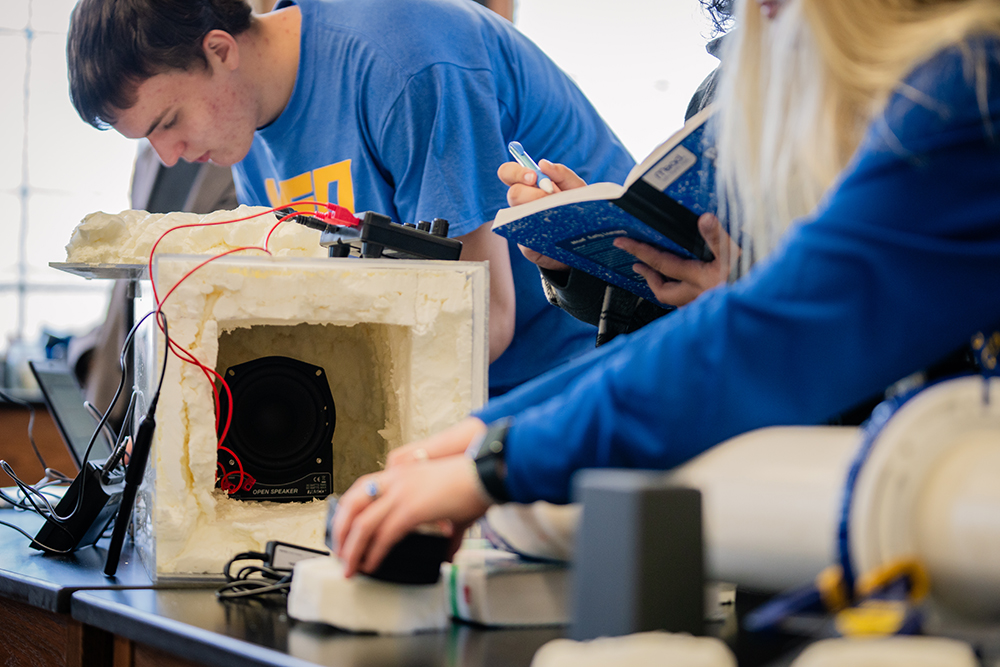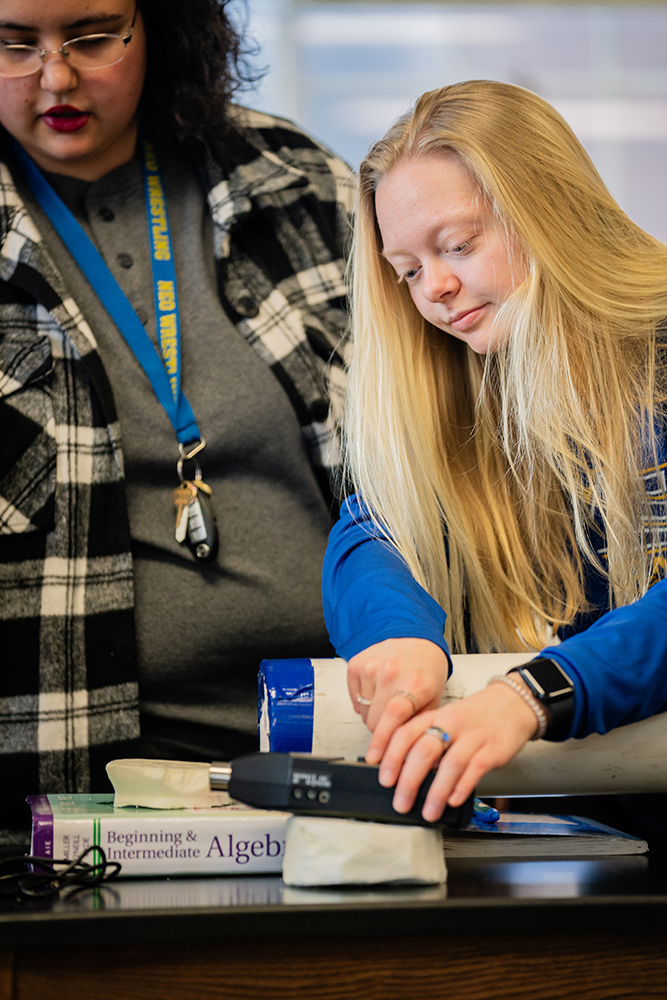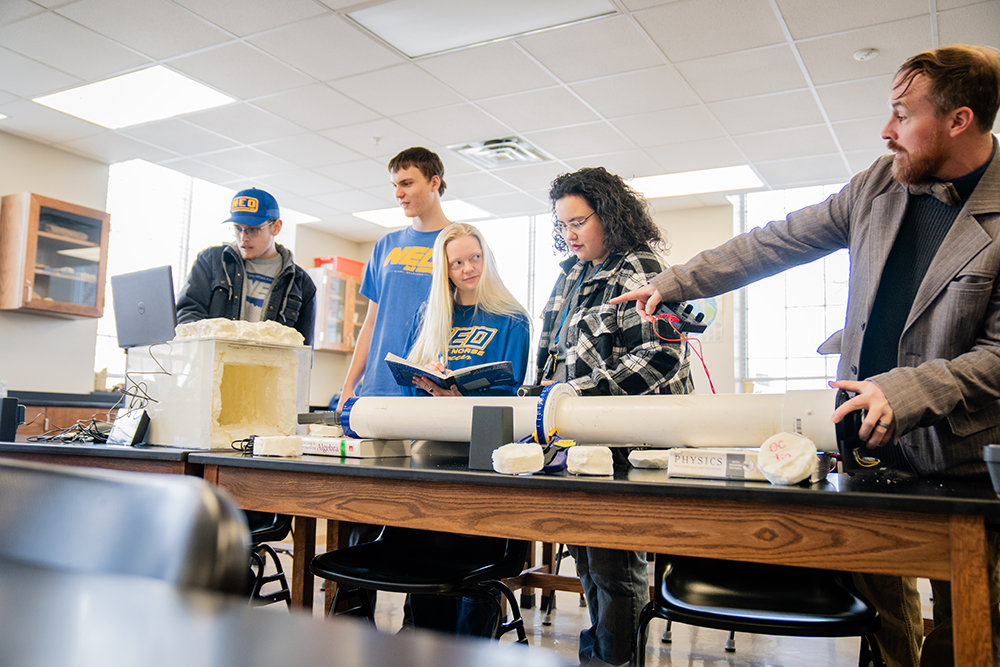
- Articles
The Northeastern Oklahoma A&M College STEM Club project and team were accepted into the 2024 NASA Minority University Research and Education Project Innovative New Designs for Space challenge. The NEO team was awarded funds to design and build a prototype of their proposed acoustic panels to reduce noise on the Artemis mission spacecraft and in lab buildings on the moon’s surface.
The NEO STEM Club was founded in 2022 as the Environmental Science Club, sponsored by NEO faculty Brad Claggett, instructor of geology and environmental science. Current members include STEM Club president and NASA MINDS project lead Nathaniel Dean, vice president Chris Gutierrez, secretary Emilee Warrior, treasurer Castan Macy, Lindsey George, and Kimberly Be.
 “I am proud to lead this project and be part of the NEO STEM Club as we pursue innovation and creative prowess through the scientific method,” said Dean. “I am very excited to see where this project takes us, where it takes NEO and the future of our research and future research on campus.”
“I am proud to lead this project and be part of the NEO STEM Club as we pursue innovation and creative prowess through the scientific method,” said Dean. “I am very excited to see where this project takes us, where it takes NEO and the future of our research and future research on campus.”
According to the NASA MINDS website, noise levels caused by hundreds of fans, motors, and pumps on the International Space Station are too loud for astronaut comfort. Noise levels often exceed current hazard levels of 85 decibels. The NEO STEM Club will develop acoustic panels that absorb this extra, unwanted noise. The goal of the project is to create panels that reduce this unwanted noise by half in future Artemis missions.
“We applied last October with our idea for a lightweight, anti-microbial acoustic panel,” said Claggett. “Our summary was accepted, and then we were required to submit a five-page preliminary design review, which was also accepted without revisions, and that’s what won the award. If NASA is interested enough in our idea, they could take this and upscale it, put their resources into it and produce a more sophisticated product that would be used on spacecraft. A real testament to NEO’s reach and impact on a global society.”
 In a congratulatory email to Claggett and his team of STEM Club students, NASA MINDS wrote, “You identified a technology gap that is either directly related to or has strong significance to the Artemis mission, described how your project seeks to solve that gap, and provided the specific details necessary to clearly define your technical approach.”
In a congratulatory email to Claggett and his team of STEM Club students, NASA MINDS wrote, “You identified a technology gap that is either directly related to or has strong significance to the Artemis mission, described how your project seeks to solve that gap, and provided the specific details necessary to clearly define your technical approach.”
Claggett continued, “The NEO STEM Club is now in the testing and build phase of the project. We have a 15-page technical paper due in March, including a revised budget, a project video, and a conference poster. There are prizes awarded for the top technical paper and prizes awarded for first, second, and third place overall in the competition.”
“I am proud to lead this project and be part of the NEO STEM Club as we pursue innovation and creative prowess through the scientific method,” said STEM Club president and NASA MINDS project lead Nathaniel Dean. “I am very excited to see where this project takes us, where it takes NEO and the future of our research and future research on campus.”
NASA MINDS is a multi-semester undergraduate-level challenge that provides funds to student and faculty teams from minority-serving institutions to design and build prototypes for technologies needed in support of the mission.
The NASA Minority University Research Program (MUREP) strives to ensure that underrepresented and underserved students participate in NASA education and research. NEO has a 2,040-square-mile primary service area, home to 10 tribal jurisdictions. Native American students represent 13 percent of the college’s fall 2023 enrollment.
“Students’ skills, creativity and innovation are challenged as they are asked to design and build technologies needed for NASA’s Artemis mission, with the support of their faculty,” according to the NASA MINDS website. “NASA MINDS is a hands-on design and build collegiate learning experience. The most unique feature of NASA MINDS is found in its broad-based approach. While competitions focus on a specific technology all teams must work on, teams in NASA MINDS will independently select a technology relevant to NASA’s Artemis mission.”
 The goal of NASA MINDS is to build a diverse science, technology, engineering, and math STEM workforce by engaging students in authentic hands-on learning experiences involving NASA’s content and people, to increase students’ capabilities to pursue STEM by empowering students to work independently on NASA Artemis technologies that interest them.
The goal of NASA MINDS is to build a diverse science, technology, engineering, and math STEM workforce by engaging students in authentic hands-on learning experiences involving NASA’s content and people, to increase students’ capabilities to pursue STEM by empowering students to work independently on NASA Artemis technologies that interest them.
NASA MINDS also aims to create a pipeline for NASA’s future workforce needs by informing students of the technological innovations required and engaging them in these technologies at a fundamental and exploratory level and to generate unique and innovative concepts from students and minority-serving institutions, which can serve as a potential resource for NASA’s scientists and engineers working on Artemis technological needs.
For more information, contact NEO STEM Club sponsor Brad Claggett at brad.claggett@neo.edu or 918-542-6380.
NASA MINDS
https://nasaminds.org